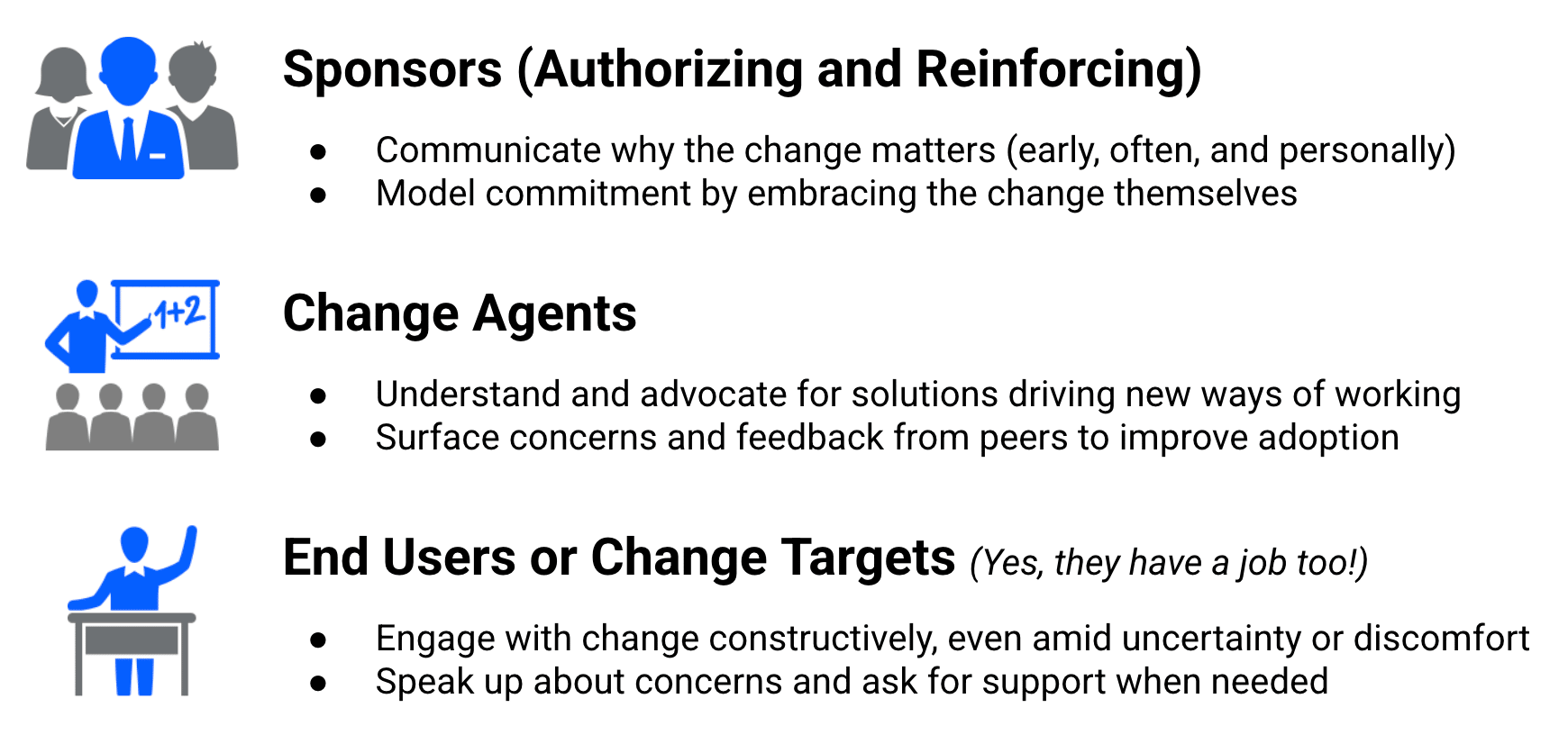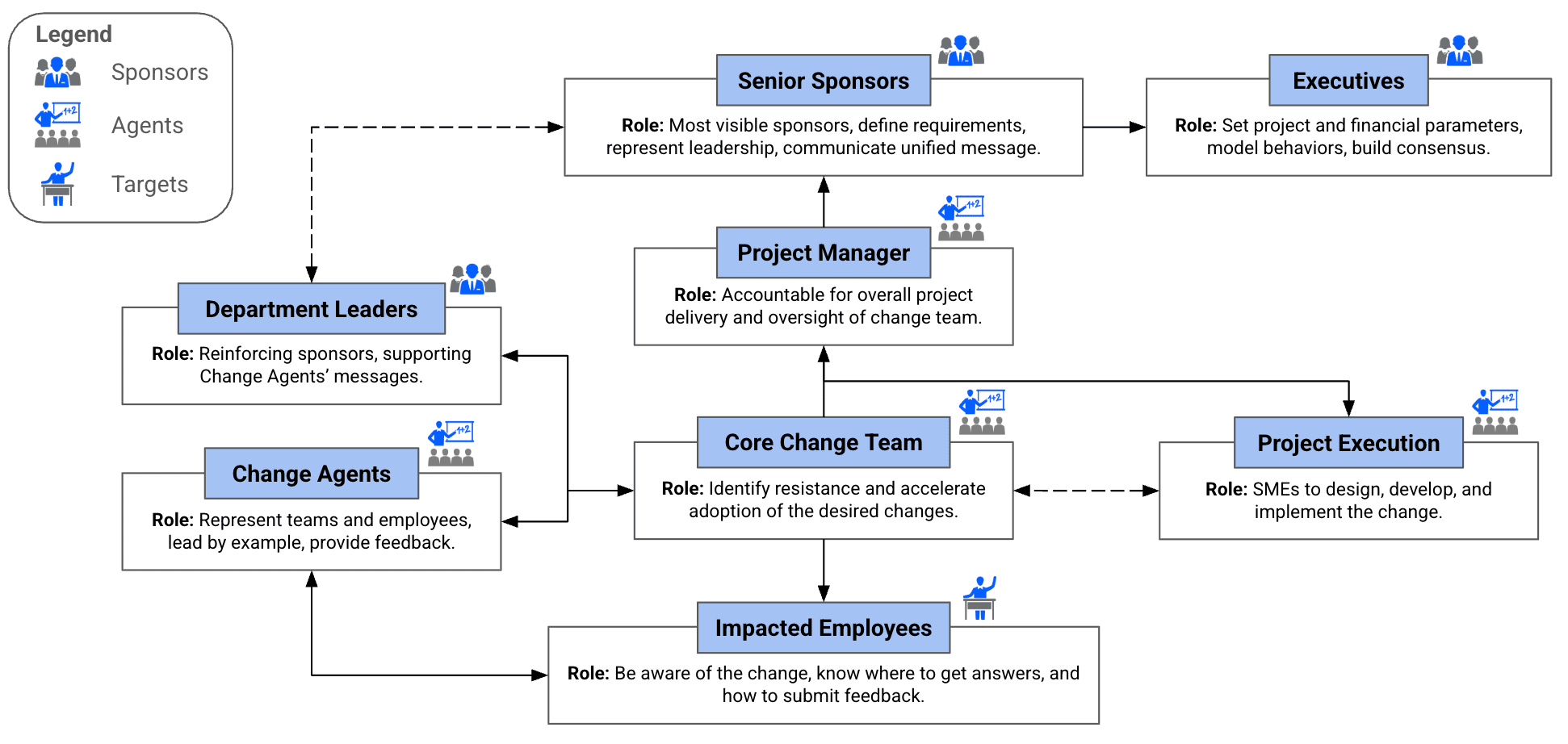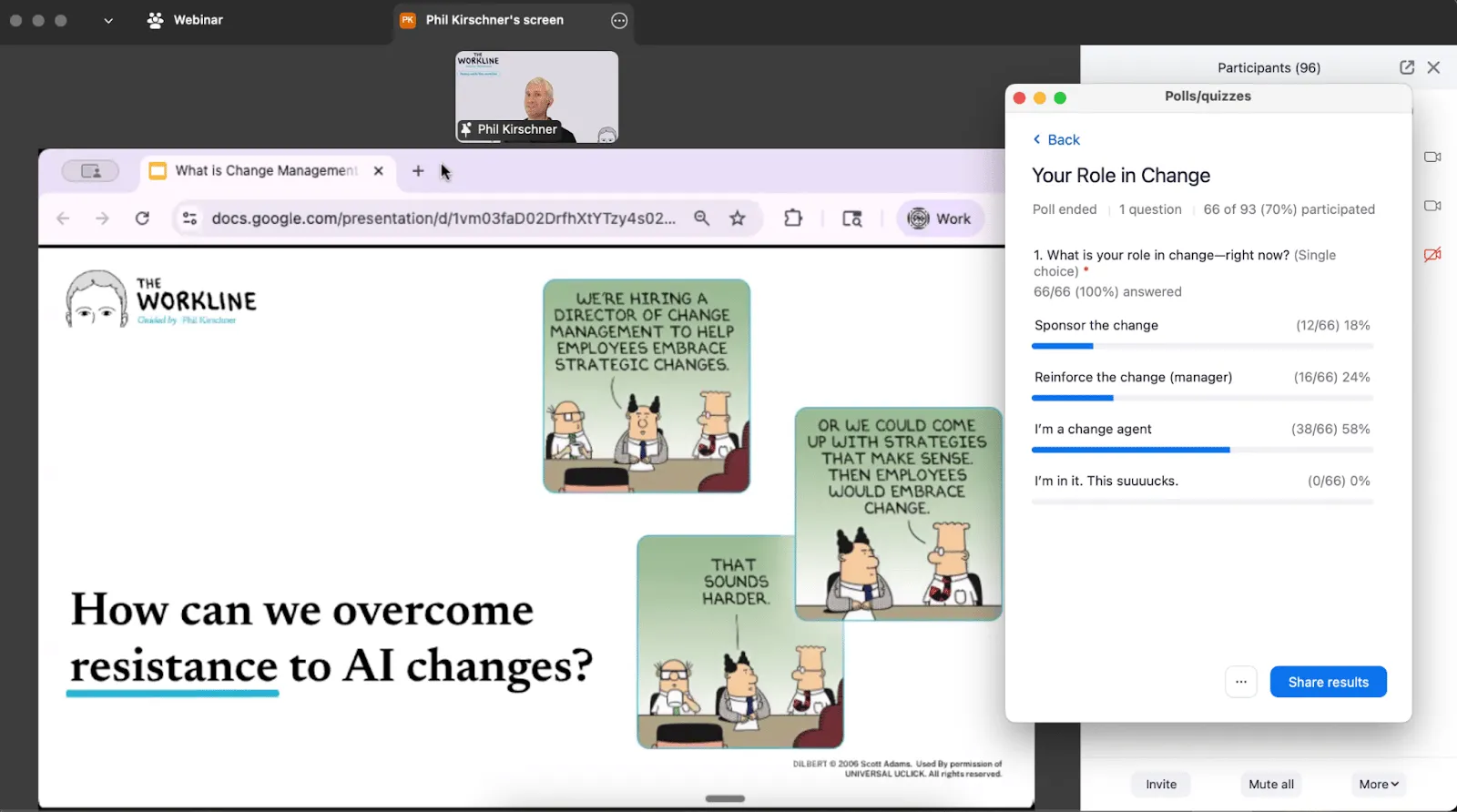Lights, Camera…Confusion? Your Change Needs Better Casting.

When I asked my AI change management webinar attendees what role they play in transformations, the split was exciting: 60% identified as change agents, 40% as sponsors. These were exactly the right leaders for a discussion about employee resistance to AI rollouts.
The second poll result, however, caught me off guard. When asked whether their organizations had repeatable change processes, only 21% said yes. The rest described their approaches as inconsistent (40%), nonexistent (32%), or weren't sure (7%).
Lead Across the Lines of Modern Work with Phil Kirschner
Over 22,000 professionals follow my insights on LinkedIn.
Join them and get my best advice straight to your inbox.
We have passionate advocates without playbooks and sponsors without structure.
I've observed this disconnect in dozens of workplace transformations: even the most committed execs struggle with change program role definitions.
Role clarity isn't a skills problem, it's a systems problem. McKinsey's research identifies it as a 'power practice' that can have disproportionate effects on organizational performance.
I've shared several change management best practices before—define the change, set a "North Star" vision, map resistance. These frameworks work, but only when people know who is responsible for which one.
Four Characters in Every Change Story
The LaMarsh Managed Change methodology taught me that every successful transformation depends on four distinct roles—each with responsibilities that can't be delegated or ignored.
🧠 Authorizing Sponsors set strategic direction and unlock resources. Many executives believe sponsorship means giving initial approval, but the real job is making hard decisions, resolving conflicts, and demonstrating commitment through visible actions.
📣 Reinforcing Sponsors bridge strategy with reality. Typically mid-level managers, they link the boardroom message to the breakroom gossip. They help teams understand how change affects their work and prevent old habits from resurfacing.
👫 Change Agents advocate for new ways of working from within. They model behaviors, communicate under pressure, and embrace uncertainty with curiosity. Their job is to coach peers through adoption, and serve as early warning systems for emerging resistance.
🎯 Change Targets (or “End Users”) have the hardest job: adapting their behaviors while at least trying to be productive. Successful targets become active participants rather than passive recipients. They engage with the change process and voice concerns to improve (not derail) progress.

When Actors Break Character
An often overlooked source of change resistance is role confusion. It's not great when employees don't understand what's changing holistically, but it's worse when they aren't clear about who is leading it.
For example, Sponsor Resistance could be an exec who claims the new AI tool will be revolutionary, but never attends training or uses it. Change Agent Resistance could be leaders nominating a beloved but over-committed employee who can't fully support teammates.
If your change program has stalled, consider if lack of credible sponsors or empowered change agents are part of the problem.
In addition, Target Resistance can arise when unique concerns are incorrectly overlooked as generalized anxiety. Perhaps everyone dislikes the new tool, but only Finance may face layoffs because of it.
Assigning Parts in Your Play
The characters above provide a solid foundation when defining a change, but I have learned they are not granular enough to describe all the different players involved in large-scale transformations.
As a result, I created an org chart that clarifies responsibilities and communication flows across eight distinct roles in any change initiative. .

🎁 Read to the end for a free version of the chart you can fill out. 🎁
🧠 Authorizing Sponsor Role:
- Executives set project and financial parameters, model behaviors, and build consensus.
- Senior Sponsors (or "Steering Committee") define requirements, represent the executives, and communicate a unified vision.
📣 Reinforcing Sponsor Role:
- Department Leaders bridge strategic vision with daily operations, managing local adoption, and reinforce Change Agents messages.
👫 Change Agent Role:
- Project Manager accountable for overall project delivery and oversight of the change program and core team.
- Core Change Team hunts down resistance patterns and designs change acceleration strategies.
- Project Execution builds, tests, and implements the actual transformation elements (e.g., installs the tech, moves the office).
- Change Agents (or "Ambassadors") are embedded within departments to model behaviors, surface concerns and feedback.
🎯 Change Target Role:
- Impacted Employees navigate behavioral shifts while maintaining productivity and engagement...or burning out when they can't.
This isn't about unnecessary structure, it's about clarity. When everyone knows their lane, transformations move faster and encounter less friction.
🍿 Webinar Replay
Missed my webinar on AI rollout change resistance? Get the replay, presentation, and resources here!

Review Your Cast List
Role definition is the missing connector that makes existing change tools actually work. When you have clear vision + defined change + known resistance + role clarity, your transformation is more likely to stick.
Audit your current transformation with three questions:
- Can you write specific names for each of the eight functions? If not, you have gaps that will become problems.
- What happens when each box encounters resistance? Do they have clear escalation paths and decision-making authority?
- Who's responsible for course-correcting when roles break? Successful changes have human sensors monitoring the system.
And forward this email to colleagues you want to engage in the problem.
The question isn't whether change will happen—it's whether you'll have the right people in the right roles when it does.
Those 100+ change leaders on my webinar represent thousands of transformations happening right now. When we get role clarity right, we can lead sustainable organizational change.
Every change story has a cast of characters. Don’t start the show until everyone knows their part.
- Phil

Lead Across the Lines of Modern Work with Phil Kirschner
Over 22,000 professionals follow my insights on LinkedIn.
Join them and get my best advice straight to your inbox.


